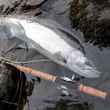Minnesota and Wisconsin must have some of the highest tarpon-rods-per-capita in the country, outside Florida. Most of these rods, of course, will never see a drop of salt water, unless you count tears — because musky anglers shed plenty, whether from icy November gales, chronic tendonitis, or the worst of all, trout sets.
But one thing we aren’t crying about any more is the struggle to find a decent musky rod. Big, stiff, saltwater rods were the only option back when the musky craze kicked off a decade or so ago, but now there’s a fistfull of specialty “predator” rods on the market, some made by rod designers that understand that you don’t use a musky rod the same way you use a tarpon rod.
A saltwater big-game rod is designed to be fast and light, for occasionally placing small flies accurately in the wind, while still having an iron backbone for wearing out giant fish. They are refined and strong, yet delicate, and carefully stowed when not on the bow of the skiff.
A musky rod needs to be fast enough to cast giant, heavy flies on heavy lines, yet still forgiving enough to do so all day long. It needs to battle a giant fish just long enough to get it in the net — think roping a steer, not braking a locomotive — and be durable enough for driftboat duty on the rocky, woody rivers of the upper Great Lakes.
A quick note on rod weight ratings. For the size of musky flies that I prefer to fish — based on ones I’ve been given or purchased from some of the best tiers and guides in the business — a 450-grain full-sink line is perfect. It really takes an 11-weight rod to cast these. A ten with a 400 is fine for smaller flies, and late-season giant hunters might prefer a 12-weight with a 500 or 550-grain line. But the 11-weight class is the bread-and-butter.
Of course — in the hands of the right caster, and paired with the right line, any rod can be workable. Lots of muskies have been landed on unsalted tarpon rods, however inelegantly.
But there is one other major problem with these rods: cost. A budget-minded angler looking for a five-weight or eight-weight rod has plenty of options, and many good ones. Not so with 10 and 11 weight rods, which often approach a thousand bucks. There are budget 10 weights — and a very few 11s — but too often they’re either a telephone pole or a noodle.
But now, we have musky-rod options. Sometimes they’re simply rebadged saltwater rods, and sometimes they’re purpose-built. Usually, you’ll see an extended fighting butt, and sometimes extended full-wells grip. Most of the time, like any specialty rod, they’re placed near the top price level of a given company’s lineup.
Which is why when I saw that Orvis was introducing an 11 weight, 9’4” rod in their entry-level Clearwater line, I was intrigued. I’ve got a couple other Clearwater rods, and find them to be better than you’d expect for the price. They’re made in Asia, like all rods at this price point, but designed by the same rod shop that gave us all three award-winning Helios designs.
The Clearwater rod series is the epitome of my budget gear-buying rule: always choose low-priced models from a high-end company, rather than high-priced models of an entry-level company.
Once I got a demo in my hands, I was more impressed. Our musky camp crew took it on a three-day late October snow squall in northern Minnesota. We had wind, cold, waves, and very few fish encounters. We didn’t have time for lots of line swapping, wiggle tests, or distance casting. We just fished.
What works
The design choices
On paper, it’s almost the perfect musky rod. It’s an 11 weight, which already puts it in the vast minority of budget rods of any style. The extended fighting butt is a great feature for deep figure-eights, or what Wisconsin guide Chris Willen once called “fifty percent of your cast.” Orvis went a step further and actually added the 4” of fighting butt to the rod length — it’s 9’4” overall. They also upgraded the reel seat design from the previous Clearwater models, which is extra nice as reels tend to loosen up when you’re casting all day. The double locking rings are heavily knurled so you can check tightness even with gloves on. One wish-list item left unchecked is an extended grip on the front of the full wells — which adds nice leverage for musky wrangling, and the option of two-hand casting — but that’s surely too much to ask at this price point.
The taper
During our blizzard musky camp, this rod handled my standard 10-14” flies comfortably with both the 450-grain Orvis PRO Depth Charge and with my go-to 450-grain Scientific Anglers Sonar Sink 25 Cold. It’s labeled as a “fast” action but it doesn’t feel “fast” compared to the 11-weight Helios 3D, or my 11-weight Helios 2. It’s soft in the right places to cushion the shock of your wet fly when your timing isn’t perfect, while still having a very low perceived swing weight. It’s a highly fishable rod that didn’t wear us out.

As for fish fighting: well, muskies just need to be horsed. You give them no quarter, no slack, no line. As long as it’s not a noodle, any heavy rod will do the job. While we didn’t land any muskies that weekend, a friend of mine landed no less than three in one day on the Clearwater this fall, and said it wrangled them handily.
The overall fit and finish
If you look closely, you can see imperfections in the epoxy and thread wraps; that’s true for most imported rods. But the effect of the grey blank, modern badging that aligns with the H3’s styling, and subdued colors is that of a rod that’s not trying to be something it’s not. Same for the grip: rubberized on the ends, decent cork in the middle. It’s not a fancy rod. It’s a working rod. Get it dirty and slimy, and forget about it. It’ll do the job.
The price
At $249, this rod has no business casting this well, or having these wish-list features. It comes in significantly lower than its closest competitor, the TFO Esox, which is itself a great value. Personally, I think the Clearwater is the better rod, too — especially when it comes to swing weight. And it’s backed by the Orvis 25-year warranty.
What doesn’t work
The timing
I wish Orvis had released this rod five years ago. I have a pile of cheap-to-mid-priced 10 and 11 weights, none of which hit the spot just right. I’ve been asked “what rod should I get for muskies?” dozens of times, and until now, I had no go-to answer, at any price. The Clearwater fits, for any angler, from dabbler to musky junkie.

Final Word
Are there nicer-looking musky rods available? Are there lighter, faster musky rods available? Yes to both. But not at this price. Not even close. There are also a lot of heavy, clunky, imported 10 and 11 weight rods out there for this price — and more — that are no fun to cast, let alone all day.
A musky guide boat would be well-equipped with a handful of these in the racks, and so too would a first-time musky-curious angler be well-armed with one as their first toe-dip into the world of Esox.
LEARN MORE ABOUT THE ORVIS CLEARWATER 11-WEIGHT 9'4" FLY ROD (via Orvis)





























Comments